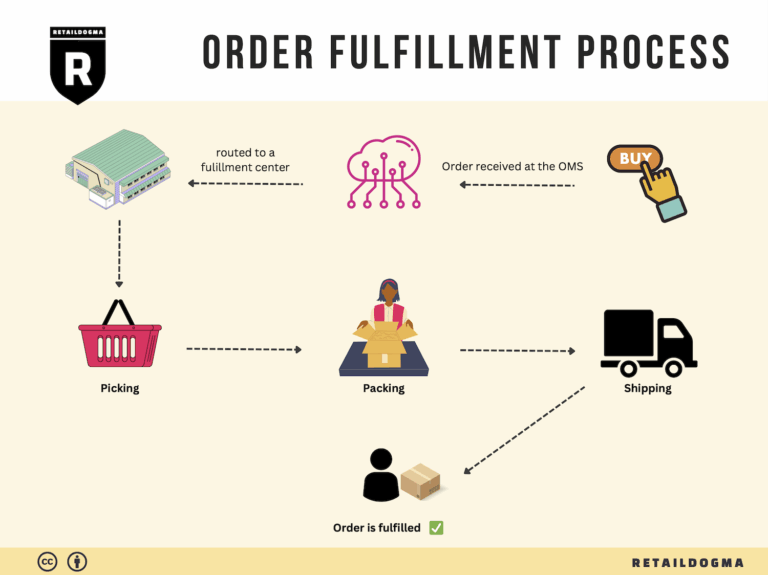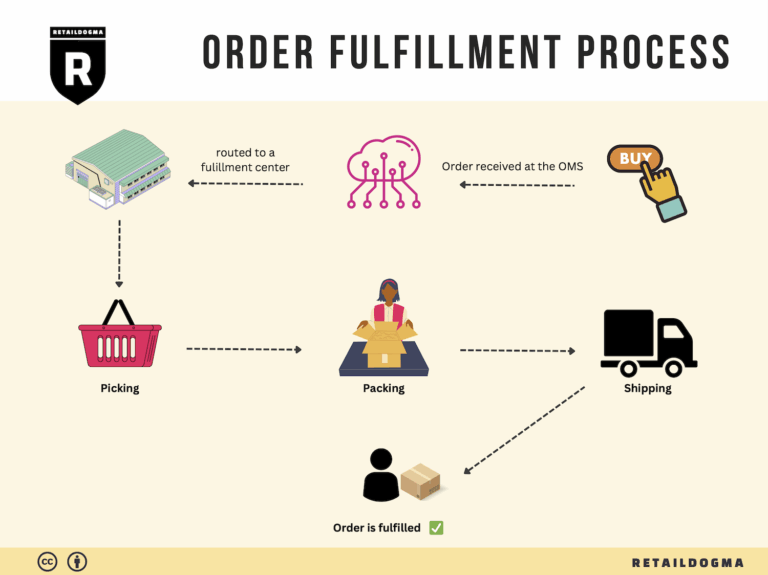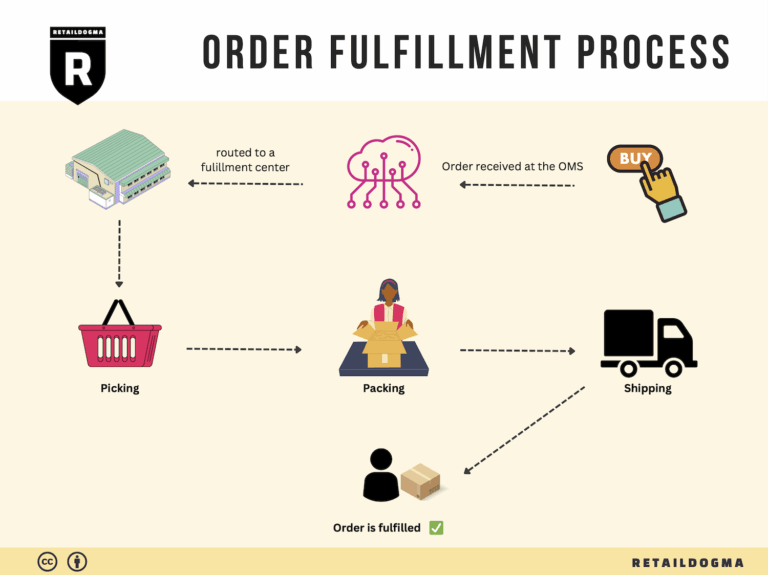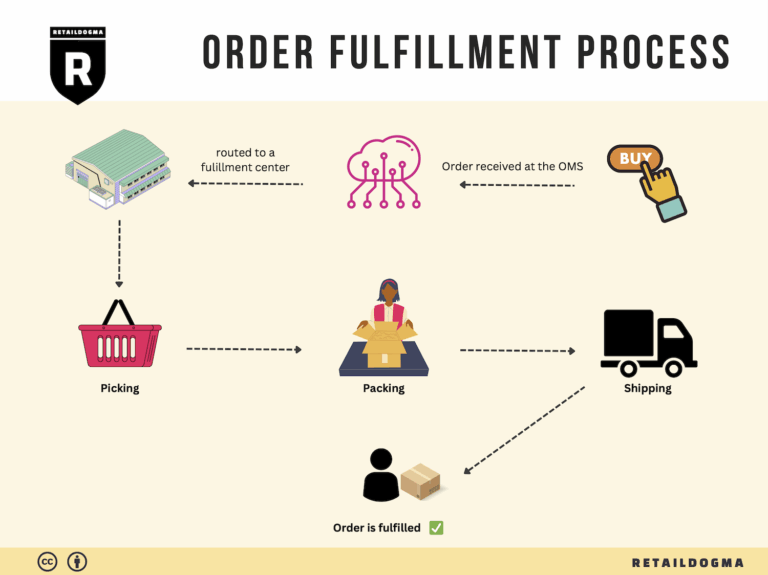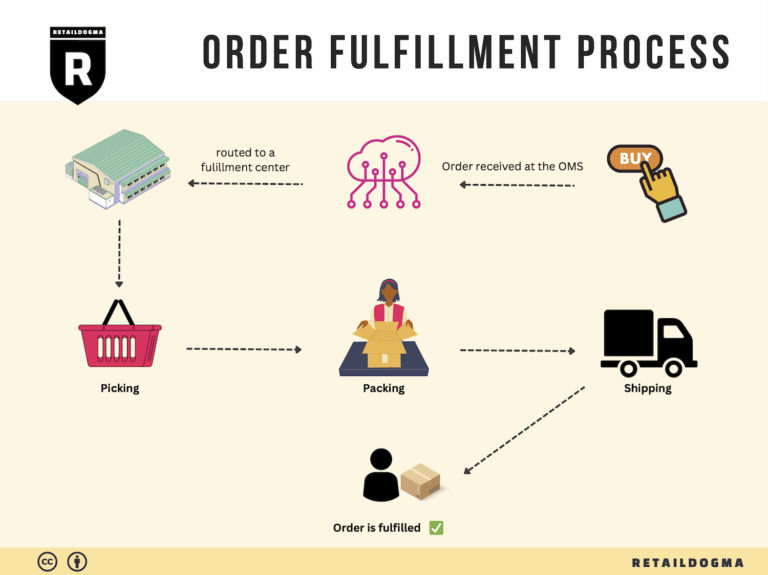What Is A Fulfillment Center? A Complete Guide (2025)
What is E-commerce Fulfillment? An Introduction for Growing Businesses
Understanding E-commerce Fulfillment
As your online business begins to flourish, the excitement of increasing sales can quickly turn into the stress of managing logistics. Packing, shipping, and tracking orders can become overwhelming, consuming valuable time and resources that could be better spent on scaling your brand. This is where e-commerce fulfillment comes into play, serving as a lifeline for growing businesses.
E-commerce fulfillment is essentially the process of getting a product from your inventory into the hands of your customers. It encompasses everything from order processing and inventory management to packing and shipping. A seamless fulfillment process not only ensures that customers receive their orders on time but also enhances their overall shopping experience, which is crucial for retaining customers and fostering loyalty.
In this guide, we will explore various aspects of e-commerce fulfillment to help you navigate this critical component of your business. We’ll delve into different fulfillment models, such as Third-Party Logistics (3PL) and Fulfillment by Amazon (FBA), each offering unique advantages depending on your specific needs. Understanding these models will empower you to select the one that aligns best with your business strategy.
Additionally, we will outline the core services offered by fulfillment providers, including order processing, inventory management, and shipping solutions. Knowing what to expect from a fulfillment partner can help you establish clear expectations and drive better outcomes for your business.
Choosing the right fulfillment partner is a pivotal decision that can significantly impact your operations. We will provide practical guidance on what to consider when selecting a partner, including their technology capabilities, customer service, and scalability options. This information will equip you with the tools to make an informed choice that supports your growth ambitions.

Finally, we will discuss pricing structures associated with fulfillment services, helping you to understand the costs involved and how to budget effectively. Transparency in pricing is crucial for maintaining healthy profit margins and ensuring that you are not blindsided by hidden fees.
The ultimate goal of this guide is to empower your business to make smart, strategic decisions about your logistics and fulfillment processes. By understanding the landscape of e-commerce fulfillment, you can streamline operations, enhance customer satisfaction, and position your business for sustainable growth.
What You’ll Learn In This Guide
- What is E-commerce Fulfillment? An Introduction for Growing Businesses
- The Order Fulfillment Process: From ‘Buy’ Button to Customer’s Door
- Comparing Fulfillment Models: In-House vs. 3PL vs. Dropshipping
- A Deep Dive into Amazon FBA: Pros, Cons, and Who It’s For
- Core Services Offered by Fulfillment Centers
- How to Choose a Fulfillment Partner: A 6-Point Checklist
- Understanding Fulfillment Pricing: A Breakdown of Common Fees
- Frequently Asked Questions (FAQs) about Fulfillment
- Conclusion: Is Outsourcing Fulfillment the Right Move for Your Business?
- Important Disclaimer
The Order Fulfillment Process: From ‘Buy’ Button to Customer’s Door
1. Receiving Inventory
The order fulfillment process begins with receiving inventory. This step involves accepting shipments of products from manufacturers or suppliers. During this phase, it is crucial to verify the received items against purchase orders to ensure accuracy. This includes checking quantities, quality, and condition.
Importance: Accurate inventory receipt is fundamental for maintaining reliable stock levels and avoiding discrepancies that could lead to stockouts or overstock situations. A systematic approach to receiving, often facilitated by a barcoding system or RFID technology, enables businesses to track products efficiently.
Key Term: SKU (Stock Keeping Unit) – Each product is assigned a unique SKU, which simplifies tracking and inventory management throughout the fulfillment process.
2. Warehouse Storage
Once inventory is received, the next step is warehouse storage. This involves organizing products in a manner that maximizes space and efficiency. Products are categorized and stored in designated areas based on their SKUs, demand patterns, and size.
Importance: Effective storage solutions not only optimize warehouse space but also improve accessibility and speed of order fulfillment. For example, frequently ordered items may be placed closer to the packing area to expedite the picking process.
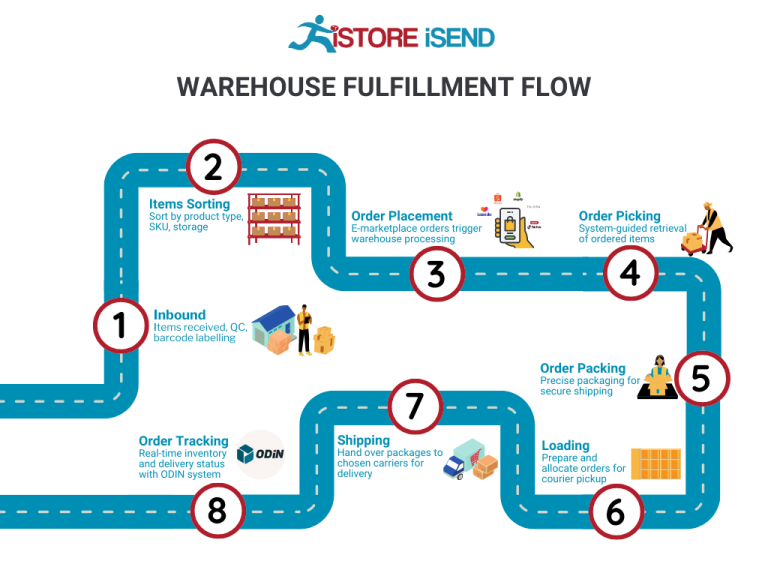
Key Term: FIFO (First In, First Out) – This inventory management strategy ensures that older stock is shipped before newer stock, reducing the risk of obsolescence and spoilage, particularly important for perishable goods.
3. Order Picking
The third step is order picking, where items are retrieved from storage based on customer orders. This process can be manual or automated, depending on the scale of the operation. Pick lists, which detail the items and quantities needed for each order, guide the picking process.
Importance: Efficient order picking is essential for maintaining high order accuracy and customer satisfaction. Errors during this stage can lead to incorrect shipments, which can harm customer relationships and increase return costs.
Key Term: Pick List – A document or digital interface that outlines the items to be collected for fulfilling a specific order, often prioritized by location to streamline the picking process.
4. Order Packing
After items are picked, the next step is order packing. This involves securely packing products for shipment, which may include using protective materials, selecting appropriate box sizes, and labeling packages accurately.
Importance: Proper packing is critical for preventing damage during transit, ensuring that customers receive their orders in perfect condition. Additionally, well-packed orders can optimize shipping costs by minimizing dimensional weight and maximizing space utilization in shipping containers.
Key Term: Dimensional Weight – A pricing technique used by carriers that considers the volume of a package relative to its weight, emphasizing the importance of efficient packing to control shipping costs.
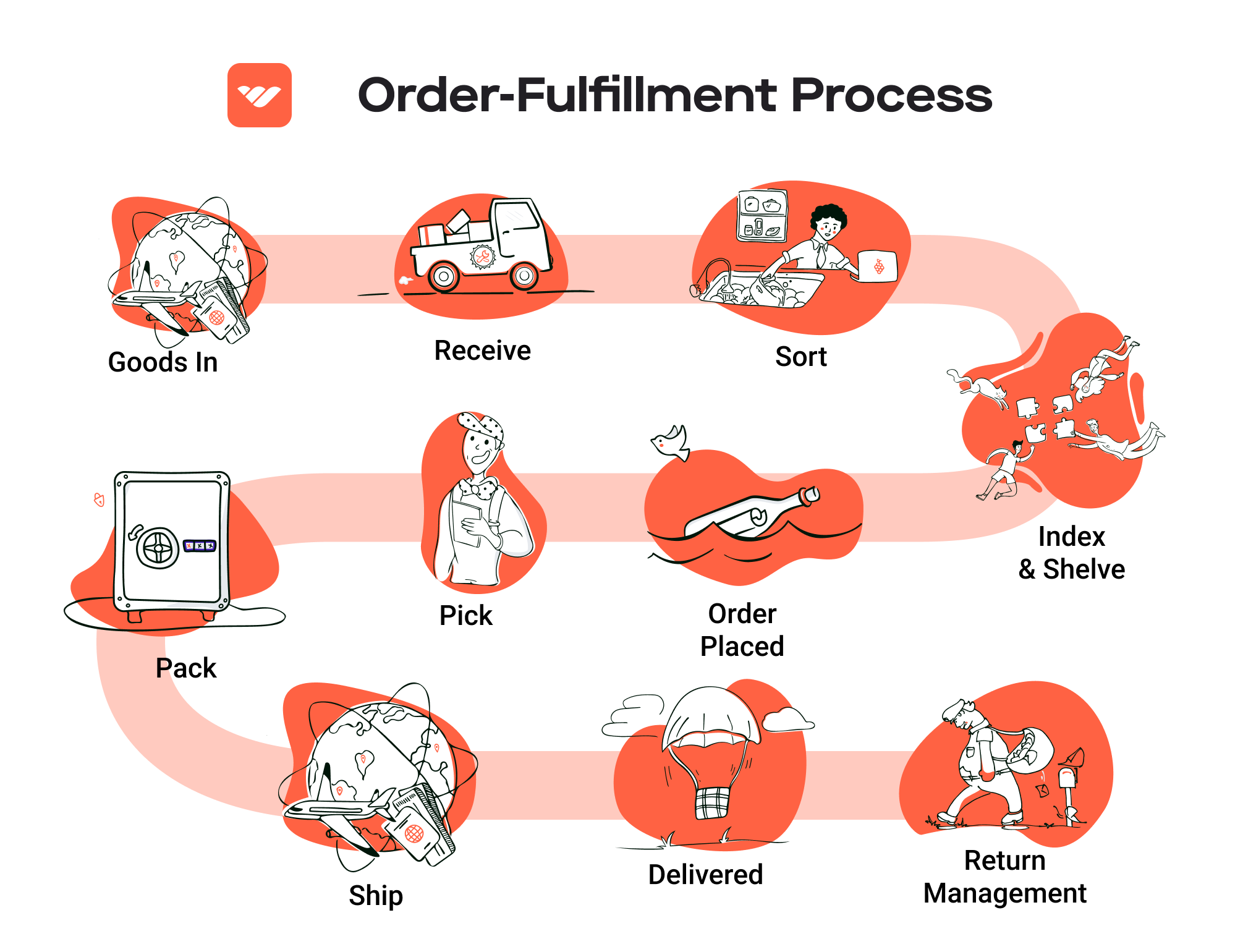
5. Shipping & Delivery
The final step in the fulfillment process is shipping and delivery. Once orders are packed, they are handed over to logistics partners for distribution. This step includes selecting the appropriate shipping method based on cost, speed, and destination, as well as generating shipping labels and tracking information.
Importance: Timely and reliable shipping is vital for customer satisfaction and retention. Many consumers today expect rapid delivery times, and businesses that can meet these expectations often gain a competitive advantage. Moreover, transparent tracking information enhances the customer experience by keeping them informed about their order status.
Key Term: Last-Mile Delivery – The final leg of the delivery process, where the product is transported from a distribution center to the customer’s doorstep, often representing the most complex and costly part of the shipping process.
By understanding and optimizing each of these steps, e-commerce businesses can enhance their order fulfillment efficiency, leading to improved customer satisfaction and ultimately, business growth. Implementing best practices in receiving, storage, picking, packing, and shipping will create a streamlined fulfillment operation capable of scaling with demand.
Comparing Fulfillment Models: In-House vs. 3PL vs. Dropshipping
Fulfillment Model Comparison
| Model | Who Handles Inventory | Best For (Business Stage) | Key Advantage | Key Disadvantage |
|---|---|---|---|---|
| In-House Fulfillment | The business itself | Established businesses with stable demand | Full control over inventory and operations | High overhead costs and labor intensity |
| Third-Party Logistics (3PL) | A specialized logistics provider | Growing businesses looking to scale | Access to expertise and technology without heavy investment | Less control over fulfillment processes |
| Dropshipping | Supplier or manufacturer | Startups or businesses testing new products | Low initial investment and risk | Lower margins and potential quality control issues |
In-House Fulfillment
In-house fulfillment involves managing all aspects of inventory storage, order processing, and shipping within the company itself. This model is typically best suited for established businesses that have a consistent demand for their products. The primary advantage of in-house fulfillment is the level of control it offers. Businesses can tailor their operations, manage inventory levels precisely, and directly oversee the customer experience. This can lead to increased customer satisfaction due to the ability to quickly respond to issues and maintain high standards. However, the disadvantages are significant; maintaining a warehouse, hiring staff, and investing in technology can lead to high overhead costs. As demand fluctuates, these costs can become burdensome, making it challenging for businesses to adapt quickly to market changes.
Third-Party Logistics (3PL)
Third-party logistics (3PL) is a model where businesses outsource their fulfillment operations to a specialized logistics provider. This is particularly beneficial for growing businesses that are looking to scale without the burden of significant upfront investment in warehousing and logistics infrastructure. A 3PL provider brings expertise in inventory management, shipping, and technology solutions, allowing businesses to focus on core activities like marketing and sales. The key advantage here is the ability to leverage the provider’s resources and knowledge, which can lead to improved efficiency and cost savings, particularly through bulk shipping discounts and optimized logistics. However, businesses relinquish some control over their fulfillment processes, which can lead to challenges in maintaining consistent customer service and adapting to specific needs quickly.
Dropshipping
Dropshipping is a fulfillment model where the retailer does not hold inventory but instead relies on suppliers to ship products directly to customers. This model is ideal for startups or businesses exploring new product lines without the financial burden of purchasing inventory upfront. The key advantage of dropshipping is the low initial investment and reduced risk; businesses can test various products and markets with minimal overhead. However, the trade-off includes lower profit margins and potential issues with product quality and shipping times. Because the retailer does not handle the product directly, they may encounter challenges in ensuring that customers receive quality products in a timely manner. Additionally, reliance on suppliers can lead to stockouts or delays, impacting customer satisfaction and the business’s reputation.
Conclusion
Choosing the right fulfillment model is crucial for e-commerce businesses looking to scale effectively. Each model—In-House Fulfillment, 3PL, and Dropshipping—has its unique advantages and challenges that can impact operational efficiency, customer satisfaction, and overall business growth. Understanding these differences will enable business owners and operations managers to make informed decisions that align with their specific needs, resources, and market conditions. Whether opting for full control through in-house operations, leveraging the expertise of a 3PL provider, or minimizing risk with dropshipping, the right choice will ultimately support the company’s strategic goals and enhance its ability to serve customers effectively.
A Deep Dive into Amazon FBA: Pros, Cons, and Who It’s For
Understanding Fulfillment by Amazon (FBA)
Fulfillment by Amazon (FBA) is a service that allows e-commerce sellers to store their products in Amazon’s fulfillment centers. Amazon takes care of storage, packaging, and shipping of the products directly to customers. This service leverages Amazon’s vast logistics network, enabling sellers to reach millions of customers efficiently. With FBA, sellers can also take advantage of Amazon’s customer service and returns handling, making it a comprehensive solution for many e-commerce businesses.
How FBA Works
-
Setup: Sellers create an Amazon Seller account and enroll in the FBA program. They then list their products on Amazon, specifying that they want to use FBA.
-
Shipping to Amazon: Sellers send their inventory to Amazon’s fulfillment centers. Amazon provides guidelines for packaging and labeling to ensure smooth processing upon arrival.
-
Storage: Once received, Amazon stores the products in their warehouses. Sellers can monitor their inventory levels through the Amazon Seller Central dashboard.
-
Order Processing: When a customer places an order, Amazon picks, packs, and ships the product on behalf of the seller. This process is highly automated, ensuring quick turnaround times.
-
Customer Service: Amazon handles all customer inquiries, returns, and refunds related to FBA orders, allowing sellers to focus on other aspects of their business.
-
Fees: Sellers pay for storage fees (based on the space their inventory occupies) and fulfillment fees (based on the size and weight of the items sold).
Pros of Fulfillment by Amazon (FBA)
-
Prime Eligibility: Products fulfilled by Amazon are eligible for Amazon Prime, which offers faster shipping options like two-day delivery. This can significantly increase sales as Prime members tend to prefer Prime-eligible items.
-
Customer Trust: Utilizing Amazon’s trusted platform can enhance customer confidence. Shoppers are more likely to purchase products that are backed by Amazon’s customer service and return policies.
-
Multi-Channel Fulfillment: FBA supports sellers who sell on other platforms, not just Amazon. Sellers can use FBA to fulfill orders from their websites or other marketplaces, streamlining their operations.
-
Scalability: FBA allows sellers to scale their business without needing to invest heavily in warehouse space, staff, or logistics management. Amazon’s infrastructure can handle increased order volumes efficiently.
-
Time Savings: By outsourcing fulfillment to Amazon, sellers can free up time to focus on marketing, product development, and other critical areas of their business.
-
Advanced Logistics: Amazon’s sophisticated logistics network allows for quick shipping and handling, which can improve customer satisfaction and retention.
Cons of Fulfillment by Amazon (FBA)
-
High Fees: FBA comes with various fees, including storage fees and fulfillment fees, which can eat into profit margins, especially for low-cost items or slow-moving inventory.
-
Strict Inventory Rules: Amazon has specific guidelines regarding inventory management, including limits on the number of units stored and strict requirements for packaging and labeling. Non-compliance can lead to additional charges or penalties.
-
Commingling Risks: FBA products from different sellers may be commingled in Amazon’s warehouses, meaning that sellers cannot guarantee their products will be shipped to customers. This can lead to potential brand damage if customers receive inferior or counterfeit products.
-
Loss of Control: By using FBA, sellers relinquish some control over the fulfillment process. Issues such as inventory mismanagement or customer service problems may arise, and sellers might find it challenging to resolve these issues quickly.
-
Seasonal Storage Fees: During peak seasons, such as the holiday shopping period, storage fees can increase significantly. Sellers must carefully manage their inventory levels to avoid unexpected costs.
-
Long-Term Storage Fees: Products that remain in Amazon’s fulfillment centers for an extended period may incur additional long-term storage fees, making it crucial for sellers to manage their inventory turnover effectively.
Who is FBA Best For?
Fulfillment by Amazon is particularly well-suited for:
-
New E-commerce Entrepreneurs: Those looking to enter the e-commerce space without significant upfront investment in logistics can leverage FBA to get started quickly.
-
Small to Medium-Sized Businesses: Companies that want to scale their operations without the hassle of managing warehousing and shipping may find FBA to be an efficient solution.
-
Brands with Established Products: Businesses with popular products that have consistent sales can benefit from FBA’s ability to handle large volumes of orders efficiently.
-
Sellers Targeting Amazon Prime Customers: Brands aiming to reach the vast Prime member base can leverage the Prime eligibility that FBA provides.
-
Multi-Channel Sellers: Businesses that sell across multiple platforms can use FBA to streamline fulfillment and maintain a consistent shipping experience for all customers.
In conclusion, while FBA offers numerous advantages such as access to Amazon’s vast logistics network and customer trust, it also presents challenges, particularly regarding fees and inventory management. Sellers should weigh these factors carefully to determine if FBA aligns with their business goals and operational capabilities.
Core Services Offered by Fulfillment Centers
Inventory Management & Warehousing
Inventory management and warehousing are foundational services provided by fulfillment centers. This process involves the systematic storage and tracking of products in a secure facility, ensuring that businesses have the right amount of inventory on hand to meet customer demand without overstocking.
Effective inventory management enables e-commerce businesses to maintain optimal stock levels, thereby reducing the risk of stockouts, which can lead to missed sales opportunities and dissatisfied customers. Fulfillment centers use advanced inventory management systems that provide real-time visibility into stock levels, order statuses, and product movements. This allows businesses to make informed decisions regarding restocking and product launches.
The benefit of utilizing a fulfillment center for inventory management is twofold. First, it alleviates the burden of managing inventory in-house, allowing business owners to focus on strategic initiatives such as marketing and product development. Second, with the centralization of inventory in a strategically located warehouse, businesses can reduce shipping costs and improve delivery times to customers, ultimately enhancing customer satisfaction and loyalty.
Pick and Pack Services
Pick and pack services are crucial for the efficient processing of e-commerce orders. This service involves the selection (picking) of items from inventory and the preparation (packing) of these items for shipment to customers. Fulfillment centers employ streamlined processes and often utilize technology such as barcode scanning to ensure accuracy in order fulfillment.
The benefits of pick and pack services are significant for e-commerce businesses. By outsourcing this function to a fulfillment center, businesses can achieve faster order processing times, which is essential in today’s competitive market where consumers expect quick delivery. Additionally, fulfillment centers typically have the resources and expertise to handle high volumes of orders during peak seasons, ensuring that businesses can scale their operations without compromising on service quality.
Moreover, an efficient pick and pack operation minimizes errors, leading to higher order accuracy rates. This not only enhances customer satisfaction but also reduces the costs associated with returns and customer service inquiries related to order mistakes.
Kitting and Assembly
Kitting and assembly refer to the process of grouping various products together to create a single, sellable unit. This service is particularly beneficial for businesses that offer subscription boxes, promotional bundles, or custom gift sets. Fulfillment centers can manage the assembly of these kits, ensuring that all components are included and presented attractively.
The primary benefit of kitting and assembly services is that they allow e-commerce businesses to offer more complex products without the need to manage the assembly process internally. This not only saves time but also enhances the customer experience by providing a ready-to-ship product that is thoughtfully curated.
Additionally, kitting can lead to increased sales as it encourages customers to purchase bundled products rather than individual items. By outsourcing this task to a fulfillment center, businesses can leverage the expertise and efficiency of professionals who specialize in kitting, ensuring that products are assembled accurately and delivered promptly.
Returns Management (Reverse Logistics)
Returns management, or reverse logistics, is the process of handling product returns from customers. It is an essential service offered by fulfillment centers, as managing returns efficiently can significantly impact customer satisfaction and retention. Fulfillment centers typically have established procedures for processing returns, including inspecting returned items, restocking them, and managing any necessary repairs or refurbishments.
The benefits of effective returns management are particularly pronounced in the e-commerce sector, where return rates can be high due to the inability of customers to physically inspect products before purchase. A streamlined returns process helps to enhance the customer experience by making it easy for customers to return items, which can ultimately encourage repeat purchases.
Moreover, fulfillment centers can provide valuable data on return trends, helping businesses identify potential issues with their products or descriptions. By understanding the reasons behind returns, e-commerce businesses can make informed adjustments to their offerings, reducing future return rates and improving overall profitability.
In summary, partnering with a fulfillment center for returns management not only simplifies the logistics of handling returns but also provides insights that can drive better business decisions and enhance customer loyalty.
How to Choose a Fulfillment Partner: A 6-Point Checklist
Location & Warehouse Network
Why It’s Important:
The geographical location of your fulfillment partner’s warehouses can significantly impact shipping costs and delivery times. A strategically located warehouse can reduce shipping zones, enabling faster delivery to a larger customer base, which is critical for maintaining customer satisfaction.
Questions to Ask:
– Where are your warehouses located, and how does this impact shipping times to my target markets?
– Can you provide a map of your warehouse network?
– How do you manage inventory across multiple locations?
Technology & Integrations
Why It’s Important:
In today’s digital-first environment, a fulfillment partner’s technology capabilities are crucial for seamless operations. An advanced fulfillment system that integrates with your existing e-commerce platform can streamline order processing, inventory management, and shipping logistics, thus reducing errors and improving efficiency.
Questions to Ask:
– What technology do you use for order management and inventory tracking?
– Can your system integrate with my e-commerce platform (e.g., Shopify, WooCommerce, Amazon)?
– Do you provide real-time tracking and updates for orders and inventory?
Specializations (e.g., Cold Storage, Oversized Items)
Why It’s Important:
Not all fulfillment partners are equipped to handle specialized products. If your business deals with unique items—like perishables that require cold storage or oversized items that need special handling—it’s essential to choose a partner with the necessary capabilities and certifications.
Questions to Ask:
– Do you have facilities that can accommodate specialized storage needs, such as temperature control or oversized items?
– What certifications do your facilities hold (e.g., FDA registration for food items)?
– How do you ensure the quality and safety of specialized products during storage and shipping?
Scalability & Capacity
Why It’s Important:
As your business grows, your fulfillment needs will evolve. Choosing a partner that can scale with your business ensures that you won’t face bottlenecks during peak seasons or rapid growth phases. Understanding their capacity for handling increased order volumes is key to maintaining service levels.
Questions to Ask:
– What is your current capacity for order fulfillment, and how do you handle peak seasons?
– Can you provide examples of how you have scaled operations for other clients?
– What is your process for onboarding additional resources or facilities as needed?
Pricing and Contracts
Why It’s Important:
Understanding the pricing structure and contract terms is essential for budgeting and avoiding unexpected costs. Transparent pricing models help you assess the total cost of fulfillment, including shipping, storage, and additional services.
Questions to Ask:
– Can you provide a detailed breakdown of your pricing structure?
– Are there any hidden fees (e.g., for storage, handling, or returns)?
– What are the contract terms, and how flexible are they if my needs change?
Customer Support & Reviews
Why It’s Important:
Strong customer support is vital for resolving issues quickly and maintaining a smooth operational flow. Additionally, checking reviews and testimonials from other clients can provide insights into the partner’s reliability and service quality.
Questions to Ask:
– What kind of customer support do you offer (e.g., dedicated account manager, 24/7 support)?
– Can you provide case studies or references from businesses similar to mine?
– How do you handle issues or errors in the fulfillment process?
Conclusion
Choosing the right fulfillment partner is a critical decision that can influence your e-commerce business’s growth and customer satisfaction. By using this checklist, you can systematically evaluate potential partners based on their capabilities, technology, and support structures. The right partner will not only help streamline your operations but also contribute to your overall success in the competitive e-commerce landscape.
Understanding Fulfillment Pricing: A Breakdown of Common Fees
Initial Setup Fees
When partnering with a fulfillment provider, the first cost you may encounter is the initial setup fee. This fee covers the onboarding process, which can include technology integration, inventory configuration, and training on the fulfillment system. Providers may charge a flat rate or an hourly rate depending on the complexity of your needs and the extent of the services required.
To calculate the initial setup fee, consider the following factors:
– Integration Complexity: If you require custom integrations with your existing e-commerce platforms, expect to pay more.
– Volume of SKUs: More products typically require more setup time.
– Special Requirements: Any additional services, such as kitting or special packaging, will add to this fee.
It’s essential to clarify what the setup fee includes and if there are any potential additional costs.
Receiving Fees
Receiving fees are incurred when your inventory arrives at the fulfillment center. These fees cover the labor and resources needed to unload, inspect, and categorize your products. The calculation is generally based on the number of pallets or cartons received.
Factors influencing receiving fees include:
– Volume of Inventory: Larger shipments may benefit from reduced per-unit costs.
– Condition of Goods: If your products require extra handling due to damage or disorganization, additional fees may apply.
– Specialized Inspection: Certain industries, such as food or cosmetics, may require extra inspection and compliance checks, increasing costs.
Understanding the receiving process and associated fees can help you budget effectively and avoid surprises.
Storage Fees (per pallet/bin)
Storage fees are charged for the space your inventory occupies within the fulfillment center. These fees can be calculated on a monthly basis and are typically charged per pallet or bin. The storage fee structure can vary depending on the provider’s pricing model, but it’s generally influenced by:
- Location of the Facility: Warehouses in premium locations may charge higher rates.
- Seasonality: Some providers offer reduced rates during off-peak seasons or increased fees during peak times (like holidays).
- Inventory Turnover: High turnover rates may qualify you for lower storage fees, while slow-moving inventory could incur additional costs.
Businesses should regularly assess their inventory levels and turnover rates to manage storage fees effectively.
Pick & Pack Fees (per item/order)
Pick and pack fees are charged for the labor involved in retrieving items from storage and preparing them for shipment. This fee can be structured in various ways: per item picked, per order processed, or as a flat rate for a certain number of items.
Key factors that affect pick and pack fees include:
– Order Complexity: Orders with multiple SKUs or requiring special packaging may incur higher fees.
– Volume of Orders: Higher order volumes may qualify for reduced per-order rates.
– Automation: Fulfillment centers using automated systems may offer lower pick and pack fees compared to those relying on manual labor.
To optimize costs, businesses can streamline their product offerings and analyze order patterns.
Shipping Fees
Shipping fees are often the most variable costs in fulfillment pricing and can significantly affect your overall expenses. These fees depend on factors such as package weight, dimensions, shipping method, and destination. Providers usually leverage their relationships with carriers to offer discounted rates, which can help reduce shipping costs for businesses.
Consider the following when assessing shipping fees:
– Shipping Method: Options range from standard to expedited services, affecting both cost and delivery speed.
– Destination: Shipping to rural or remote areas often incurs higher fees.
– Volume Discounts: Consistent shipping volumes can lead to negotiations for better rates.
Understanding your shipping options and how fees are calculated can lead to significant savings.
Tips for Getting an Accurate Quote
-
Be Transparent: Provide detailed information about your product types, order volumes, and specific needs. This allows fulfillment providers to give a more accurate quote.
-
Request Itemized Pricing: Ask for a breakdown of all potential fees, including initial setup, receiving, storage, pick and pack, and shipping. This transparency helps you understand where your costs will come from.
-
Consider Future Growth: Discuss your projected growth with potential partners to ensure they can accommodate your needs as your business scales.
-
Negotiate: Don’t hesitate to negotiate terms and pricing. Many fulfillment centers are open to adjusting their rates based on your business potential.
-
Review Terms Regularly: As your business evolves, revisit your agreements with fulfillment partners to ensure they remain competitive and aligned with your needs.
By understanding these common fulfillment pricing models and following these tips, you can make informed decisions that support your e-commerce business’s growth and profitability.
Frequently Asked Questions (FAQs) about Fulfillment
1. What is Aero Fulfillment?
Aero Fulfillment is a third-party logistics provider specializing in e-commerce fulfillment services. We streamline your order processing, inventory management, and shipping operations through advanced technology and centralized warehouse locations, allowing your business to scale efficiently and effectively.
2. How does Aero Fulfillment reduce shipping costs?
Aero leverages high-volume shipping discounts through established partnerships with major carriers, enabling us to offer competitive rates. Our centrally located facilities also allow for faster deliveries across the U.S., minimizing shipping zones and costs, while our transparent pricing ensures no hidden fees.
3. What is the difference between a warehouse and a fulfillment center?
A warehouse is primarily a storage facility where goods are kept until needed, whereas a fulfillment center is specifically designed for processing and shipping orders. Fulfillment centers focus on order accuracy, speed, and customer satisfaction, often integrating technology to manage inventory and logistics effectively.
4. What is a 3PL (Third-Party Logistics)?
A 3PL is a service provider that manages logistics and supply chain functions on behalf of another company. This includes warehousing, order fulfillment, inventory management, and shipping. Partnering with a 3PL like Aero Fulfillment allows businesses to focus on their core competencies while outsourcing logistics operations.
5. Does Aero Fulfillment integrate with my e-commerce platform?
Yes, Aero Fulfillment seamlessly integrates with popular e-commerce platforms such as Shopify, WooCommerce, and Amazon. This integration facilitates real-time updates on inventory, orders, and shipments, streamlining your operations and enhancing customer satisfaction.
6. How quickly can Aero Fulfillment get my business set up?
Aero Fulfillment has streamlined its onboarding process to ensure that businesses can start operations quickly. Typically, the setup takes between 2 to 4 weeks, depending on the complexity of your requirements. Our team is dedicated to providing fast, high-quality integration for a smooth transition.
7. What services does Aero Fulfillment offer?
We offer a wide range of services including e-commerce fulfillment, kitting and assembly, drop shipping, subscription fulfillment, and B2B retail fulfillment. Our solutions are tailored to meet the unique needs of various industries, ensuring that we support your specific business requirements.
8. How does Aero Fulfillment support inventory management?
Aero utilizes advanced inventory management systems that provide real-time visibility into stock levels, order statuses, and product movements. This helps you prevent stockouts, manage excess inventory, and streamline reordering processes, ensuring that you can meet customer demand efficiently.
9. What are the typical costs associated with fulfillment services?
The costs of fulfillment services can vary based on factors such as order volume, storage space, and specific services required. Aero Fulfillment offers competitive pricing with no hidden fees, ensuring transparency. For a detailed quote tailored to your business needs, we recommend reaching out for a personalized assessment.
10. What level of order accuracy can I expect from Aero Fulfillment?
Aero Fulfillment prides itself on delivering exceptional order accuracy, typically achieving rates of 99.90%. Our rigorous processes and quality control measures ensure that each order is processed accurately and efficiently, contributing to high customer satisfaction.
Conclusion: Is Outsourcing Fulfillment the Right Move for Your Business?
Evaluating the Benefits of Outsourcing Fulfillment
Outsourcing your fulfillment can be a game-changer for e-commerce businesses looking to scale. By leveraging a dedicated fulfillment service, you can save precious time that would otherwise be spent managing logistics. This allows you to focus on your core business activities—such as marketing, product development, and customer engagement—ultimately driving growth.
One of the most significant advantages of partnering with a fulfillment provider is scalability. As your business expands, so do your logistics needs. A proficient fulfillment partner can seamlessly adapt to fluctuating order volumes, ensuring that you can meet customer demands without the headache of managing warehousing and inventory complexities. This flexibility is crucial in today’s fast-paced e-commerce landscape, where consumer expectations for speed and efficiency continue to rise.
Moreover, outsourcing fulfillment grants you access to specialized expertise. Established fulfillment services, like Aero Fulfillment, come equipped with advanced technology, industry knowledge, and streamlined processes that enhance order accuracy and efficiency. This means you can trust that your orders will be processed correctly and delivered on time, significantly improving customer satisfaction.
However, the importance of selecting the right fulfillment partner cannot be overstated. Your choice should align with your business goals, values, and operational needs. A trustworthy partner will not only understand your requirements but also proactively address any challenges that arise, contributing to your long-term success.
Take Action
To determine if outsourcing fulfillment is the right step for your business, consider conducting a thorough audit of your current shipping processes. Assess your order volume, shipping costs, and operational efficiencies. By understanding where your logistics may be falling short, you can make an informed decision on whether a fulfillment partner can help streamline your operations and support your growth ambitions.
Important Disclaimer
⚠️ Important Disclaimer
The information in this guide is for educational purposes. Fulfillment services, pricing, and platform features change frequently. Always conduct your own due diligence and consult with providers directly before making business decisions.

